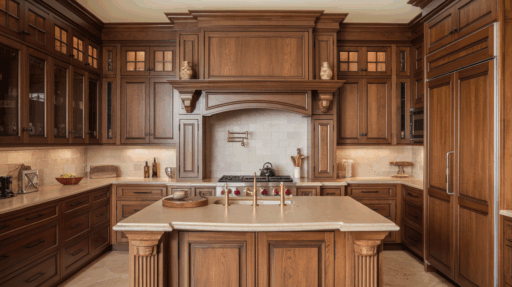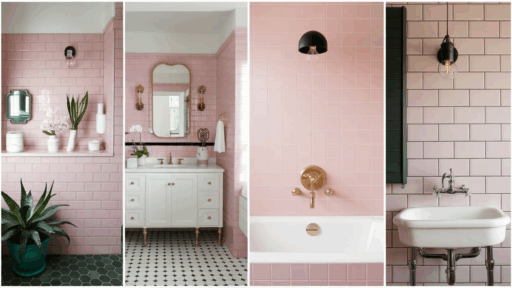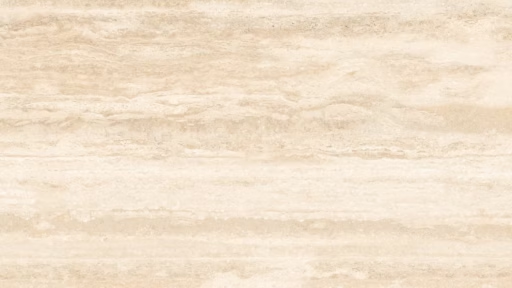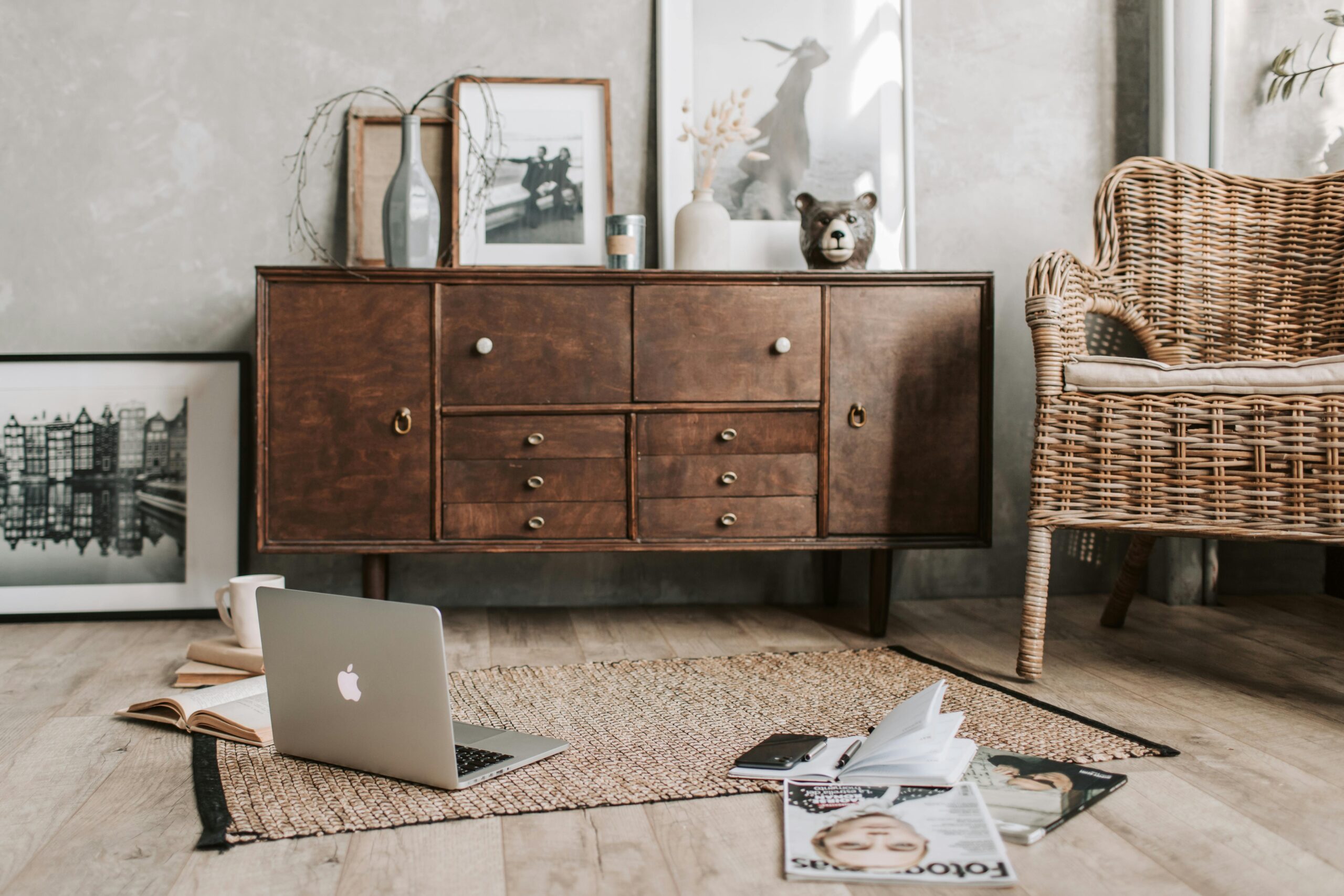When I started picking wood for my kitchen cabinets, I thought it would be simple, but I quickly realized how many choices there really are.
Each wood type has its own look, grain pattern, durability, and price point.
Some are perfect for painting, while others shine best with a natural finish. And what works for one kitchen might not work for another.
In this guide, I’ll walk you through the most popular wood species for kitchen cabinets, including their pros, cons, and what makes each one unique.
Going for modern, rustic, or timeless traditional? There’s a wood out there that fits your style and budget.
If you’re planning a remodel or simply exploring options, this guide will help you make a choice you’ll love for years to come.
Why Wood Type Matters in Kitchen Cabinets?
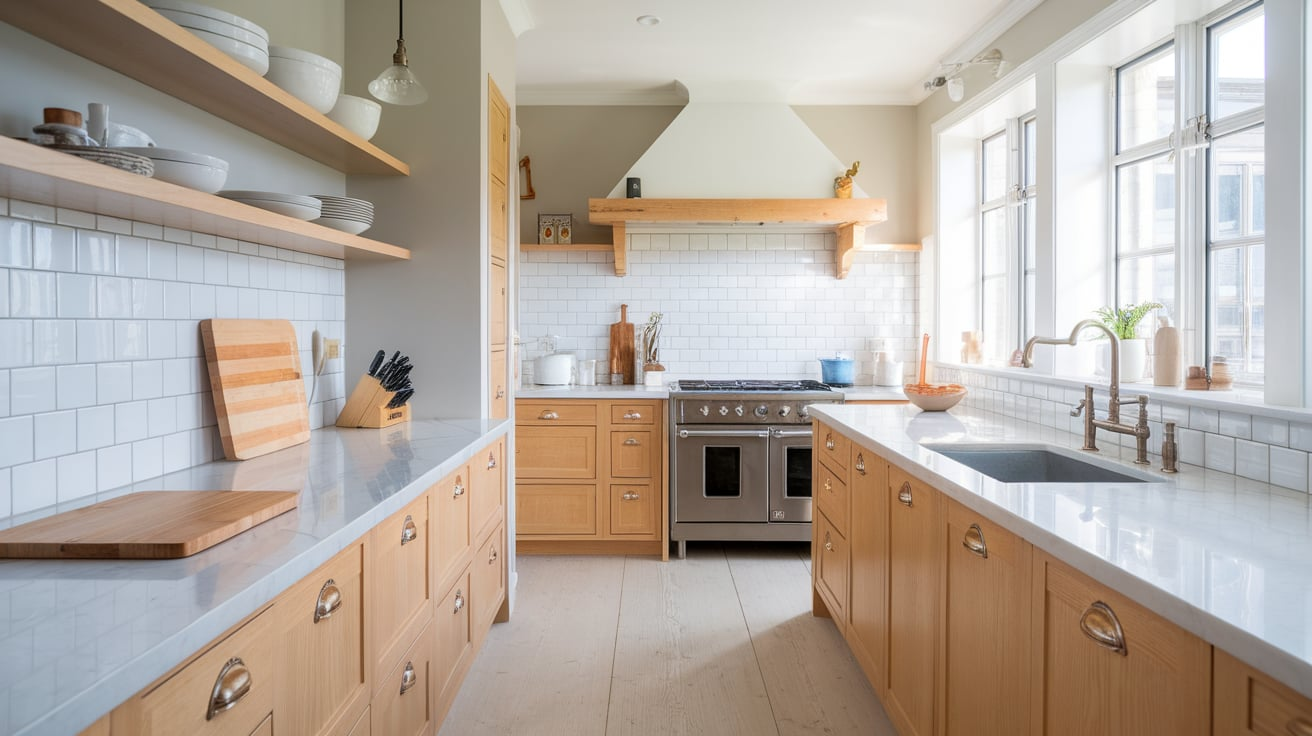
Choosing the right wood for your kitchen cabinets extends far beyond simply selecting a color or style.
It directly affects how your cabinets perform, their appearance over time, and the amount you’ll spend.
Hardwoods like oak, maple, and cherry are known for their strength and durability, making them ideal for busy kitchens where cabinets get frequent use.
On the other hand, softer woods like pine or engineered options may be more affordable but can show wear faster.
Wood type also determines how your cabinets take stain or paint, how easily they clean, and whether they’ll hold up to changes in humidity and temperature.
So if you want cabinets that look beautiful, last for years, and match your style without breaking your budget, the wood you choose really does matter.
Hardwood vs. Softwood for Cabinets
The terms “hardwood” and “softwood” don’t just describe strength; they refer to the type of tree.
Hardwoods like oak, maple, and cherry come from deciduous trees and tend to be denser with complex grain patterns.
Hardwoods usually outperform softwoods in kitchen settings due to their durability and resistance to wear.
Softwoods like pine and fir come from evergreen trees and are generally lighter and easier to shape, but they dent more easily.
Softwoods can work in lower-traffic kitchens or for painted finishes, while hardwoods are better suited for the daily demands of cooking spaces.
| Feature | Hardwood | Softwood |
|---|---|---|
| Durability | High, resists dents/scratches | Moderate, more prone to damage |
| Appearance | Rich grain, good with stain | Softer grain, good for paint |
| Cost | More expensive | Generally more affordable |
| Lifespan | Long-lasting | May wear faster over time |
| Best For | Busy kitchens, luxury finishes | Cottage styles, budget projects |
Solid Wood vs. Engineered Wood Cabinets
Understanding the difference between solid wood and engineered wood can help you make a smarter choice for your kitchen cabinets.
Solid wood offers timeless beauty and strength. It’s made from a single type of natural wood throughout and is known for its durability and premium feel.
Engineered wood, like plywood or MDF, is manufactured using wood fibers or veneers and resins. It’s more stable in certain conditions and is often used in modern cabinetry.
| Feature | Solid Wood | Plywood | MDF |
|---|---|---|---|
| Durability | High (with maintenance) | Very good | Moderate |
| Moisture Resistance | Prone to warping | Good with proper sealing | Poor |
| Best Use | Cabinet fronts, doors | Cabinet boxes, for structural use | Painted cabinet panels |
| Finish Options | Stain or natural wood tones | Veneer, paint, or stain | Best for smooth paint finishes |
| Cost | High | Moderate | Low |
Best Woods for Kitchen Cabinets
Learn how different wood types like oak, maple, and cherry affect the look, durability, and cost of your kitchen cabinets.
1. Oak

Oak is a timeless choice, known for its durability and visible grain pattern. Red oak has warm undertones, while white oak offers a cooler, more modern look.
Both types stain well and resist wear, making them ideal for traditional or craftsman-style kitchens.
Oak cabinets can be heavy-duty, lasting for decades with proper care, and they adapt well to both light and dark finishes.
2. Maple

Maple features a fine, smooth grain and a light, creamy color, making it perfect for painted or natural finishes.
It’s extremely hard and resistant to dents, making it a smart choice for busy kitchens.
Maple’s subtle grain works well in contemporary designs where uniformity matters.
Whether you want clean white cabinets or a natural Scandinavian look, maple offers versatility without sacrificing durability.
3. Cherry
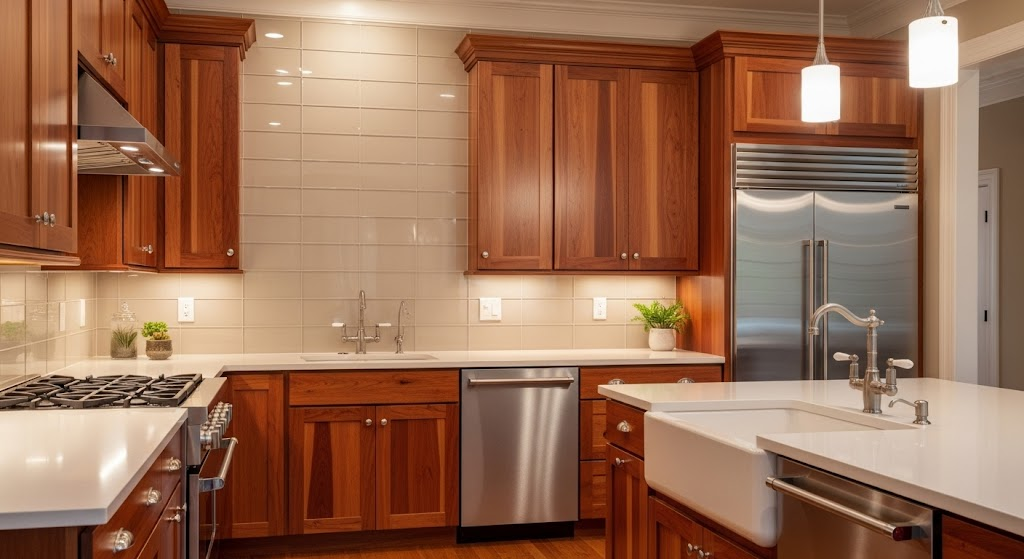
Cherry wood offers rich, reddish-brown hues that deepen over time, giving your cabinets a luxurious, evolving look.
It has a smooth, straight grain and accepts stains beautifully. Often chosen for high-end kitchens, cherry lends warmth and elegance to both classic and transitional spaces.
While it’s slightly softer than maple or oak, it holds up well in lower-traffic areas or refined designs.
4. Hickory
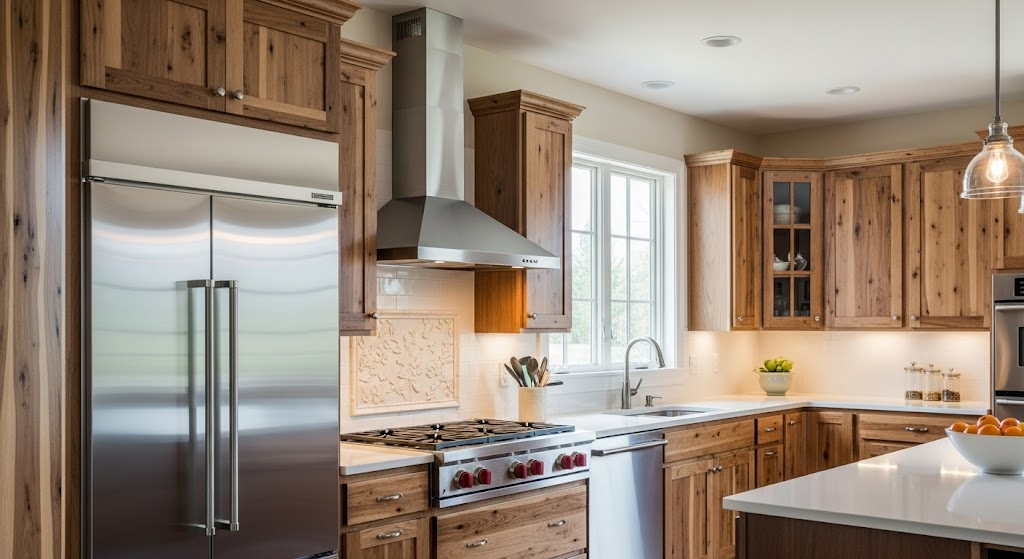
Hickory is one of the hardest domestic woods and brings a bold, rustic charm to kitchen cabinetry.
Its dramatic grain and natural color variations from light cream to dark brown make every cabinet unique.
It’s ideal for farmhouse or lodge-style kitchens.
Hickory’s toughness means it resists scratches and dents, and it pairs beautifully with matte finishes or distressed styles for added character.
5. Walnut
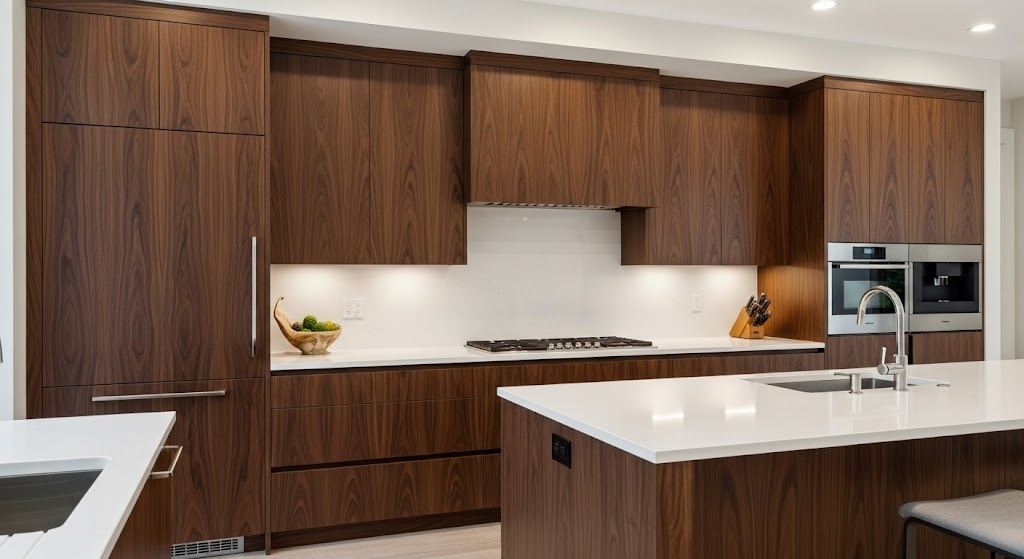
Walnut is prized for its deep, rich chocolate tones and elegant grain. It adds instant sophistication to any kitchen, whether modern, transitional, or traditional.
Though softer than maple or oak, it’s still a strong, stable wood when well-maintained.
Walnut can be left natural for a stunning warm finish or oiled to enhance its depth. It’s ideal for luxurious or statement cabinetry.
6. Alder

Alder is a softer hardwood with a straight, fine grain and light, warm tones. It’s easy to work with and takes stains evenly, often used as a budget-friendly alternative to cherry.
Alder suits rustic or distressed finishes well, making it an excellent choice for vintage, farmhouse, or country-style kitchens.
While it’s not as tough as other woods, its affordability and charm make it a solid pick.
7. Birch
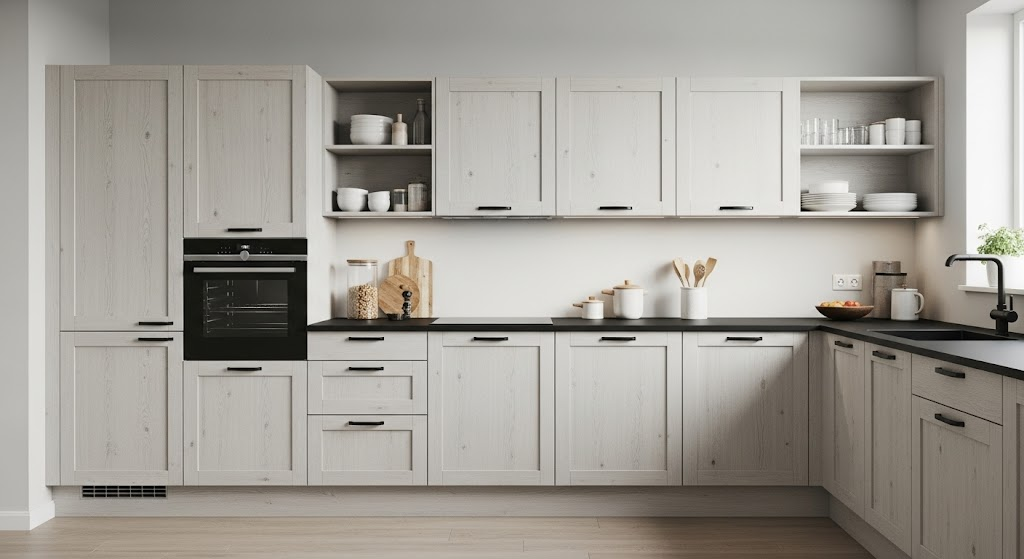
Birch has a smooth, tight grain and pale color, often used for painted finishes. It’s slightly softer than maple but harder than pine, balancing cost and strength.
Birch is versatile, working in both modern and traditional kitchens.
It can mimic the look of more expensive woods like cherry or maple with the right finish, making it a cost-effective choice for stylish cabinetry.
8. Pine
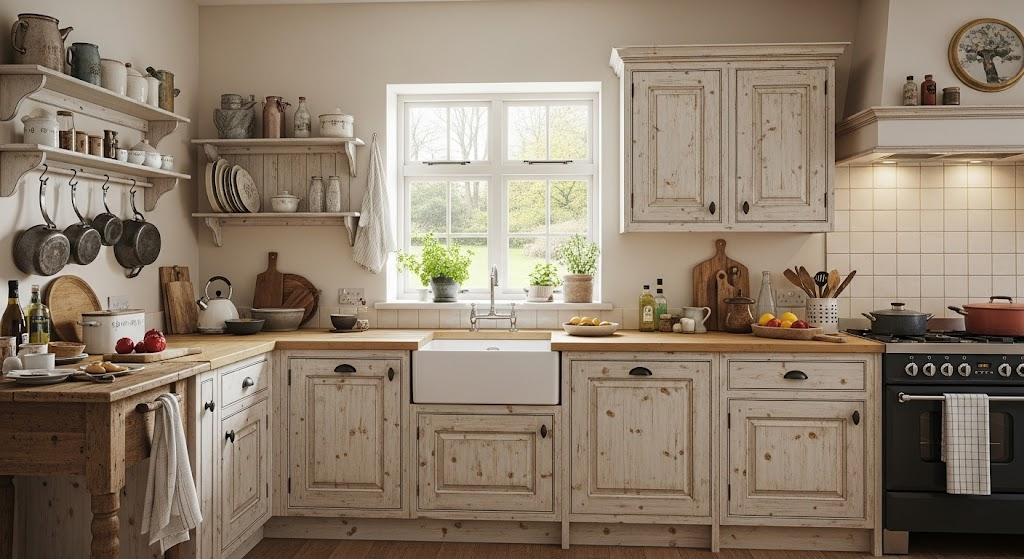
Pine is a softwood known for its rustic appeal and affordability. It features visible knots and grain that suit farmhouse or country kitchens.
It’s easy to stain or paint, though it dents more easily than hardwoods. Pine is often used for cottage-inspired cabinetry or distressed finishes.
If you’re looking for a charming, budget-friendly option with character, pine adds warmth and personality to your kitchen.
9. Ash
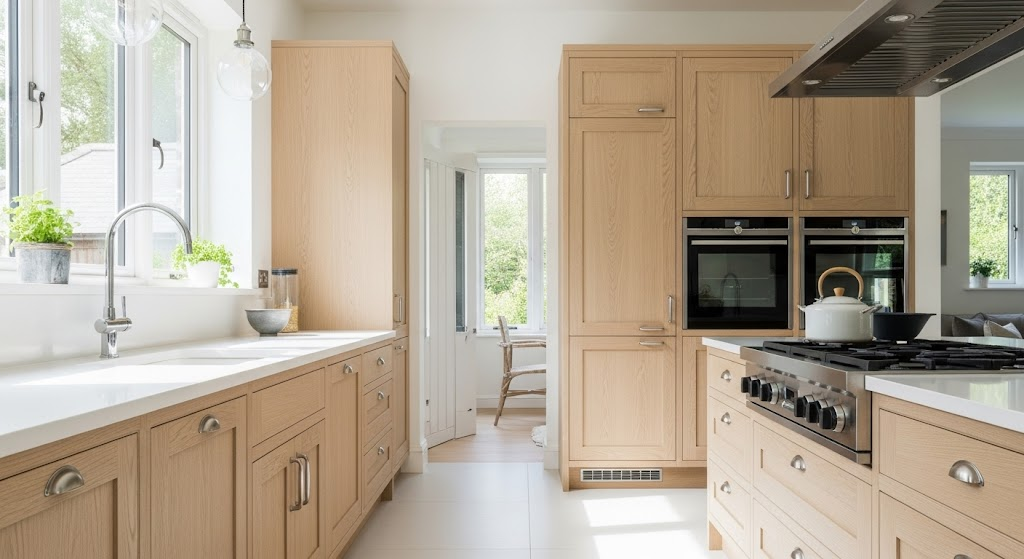
Ash has a light, pale tone and an open grain pattern that closely resembles oak. It’s strong, shock-resistant, and easy to work with.
Ash takes stain well and is often used in custom cabinetry for modern and transitional designs.
Its light color makes it ideal for bright, airy kitchens, and it’s tough enough for everyday use without compromising on aesthetics.
A quick comparison table:
| Wood Type | Grain Pattern | Color Range | Durability | Best For | Avg. Cost (USD/sq ft) |
|---|---|---|---|---|---|
| Oak | Prominent, open grain | Light to medium brown | Very strong and wear-resistant | Traditional and high-use kitchens | $8–$15 |
| Maple | Smooth, fine-grain | Creamy white to light reddish-brown | Hard and durable | Modern or transitional styles | $10–$18 |
| Cherry | Smooth with fine, uniform grain | Reddish-brown that darkens with age | Moderately hard and strong | Elegant, upscale designs | $15–$25 |
| Hickory | Bold, varied grain | Light to dark brown with color variation | Extremely durable | Rustic, farmhouse kitchens | $12–$20 |
| Walnut | Straight grain with occasional waves | Rich brown to dark chocolate | Durable, less dense than oak | Sophisticated, luxury kitchens | $18–$30 |
| Alder | Subtle, even grain | Light brown with reddish undertones | Moderately durable | Budget-friendly classic look | $6–$10 |
| Birch | Fine, uniform grain | Light yellow to pale brown | Moderately durable | Affordable clean styles | $6–$12 |
| Pine | Knotty, rustic grain | Creamy white to yellow with knots | Soft and less durable | Cottage or rustic themes | $4–$8 |
| Ash | Straight, open grain | Light to medium brown | Durable and shock-resistant | Strong, versatile cabinetry | $10–$17 |
How to Choose the Best Wood for Your Style and Budget
Below is a quick guide to help you pick the right wood for your kitchen based on your design preferences and budget:
Know Your Style:
- Like warm tones and visible grain? Try oak or hickory for rustic or traditional looks.
- Prefer smooth, clean finishes? Go with maple or birch for a modern or minimalist style.
Set Your Budget:
- Want something luxurious? Cherry and walnut offer high-end beauty but cost more.
- On a budget? Alder and pine are affordable and still look great, especially when painted or distressed.
Think About Durability:
- For busy kitchens or family homes, choose harder woods like oak or hickory for lasting strength.
- Lighter-use kitchens can get by with softer woods, which are usually more budget-friendly.
Balance Looks, Function, and Cost:
- Choose a wood that matches your lifestyle and needs without sacrificing style or quality.
Budget-Friendly Wood Options for Cabinets
Looking to save money without sacrificing style? These three wood types offer great value and a range of design options:
- Alder: Soft with a smooth, even grain. Stains beautifully and works well in rustic or transitional kitchens. Slightly less durable but very attractive.
- Birch: Durable and fine-grained. Takes paint and stain well, making it ideal for sleek, modern cabinet finishes at a lower cost.
- Pine: Light in color with distinct knots that give it a cottage or farmhouse charm. Affordable and easy to work with, though softer than other woods.
These options let you create a stylish kitchen on a budget, especially when paired with the right finish and hardware.
Conclusion
Choosing the right wood for your kitchen cabinets can feel overwhelming. I get it.
However, once you consider grain, durability, and budget, it becomes easier. You might love the elegance of cherry, the rustic feel of hickory, or the value of birch.
No matter your style or budget, there’s a wood that fits your kitchen and lifestyle.
I hope this guide gave you a clear starting point and the confidence to move forward.
Ready to plan your dream kitchen? Save this guide and explore finishes, colors, and layouts that pull it all together.
You’ve got what you need to make a smart, stylish choice.

